Harley vs. Indian: Which One Is Best for a Cross-Country Cruise?
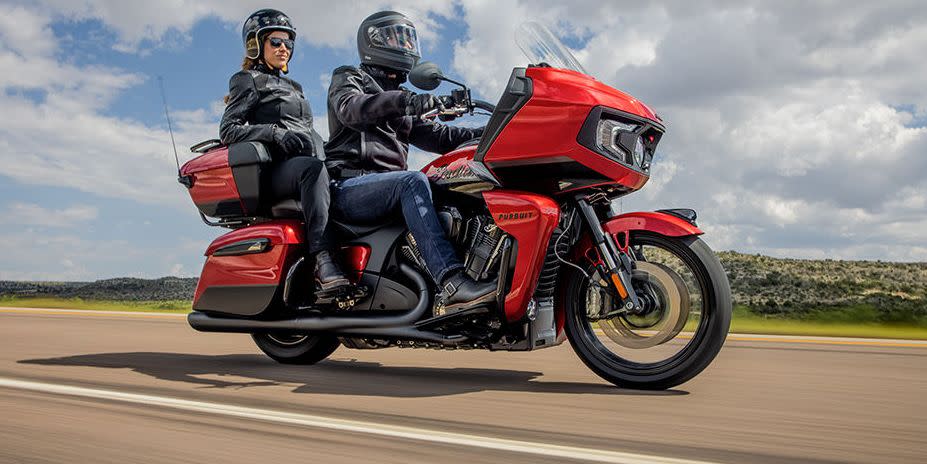
Harley and Indian have been competitors for almost 120 years, each bringing distinct offerings to the table. But they're more the same than they are different.
The Harley Road Glide Limited is 932 pounds of heavy fun, the Indian 912.
But we picked a winner, which may surprise you.
Harley fans are pretty diehard motorcycle enthusiasts. They love the motorcycle lifestyle as much as the motorcycle: the culture, the vests, the chaps, and the code of the road that has come with every Harley-Davidson ever made since the company was founded in 1903. Indian was founded in 1901 but had a few “interruptions” in production since then. There may have even been some bankruptcies. Hey, nobody’s perfect.
But since Indian’s purchase by Polaris and Harley’s new management, both companies appear to be strong and ready for the future. And both are American motorcycle icons, their rivalry as much a part of the fabric of the country as Ford vs. Chevy, Yankees vs. Mets, Coke vs. Pepsi, deep-dish-square vs. thin-crust-round. We’ll never agree.
But we can all go down to our local Indian or Harley dealers and take a test ride and decide for ourselves. I did. Actually, I borrowed a couple of big bikes, one from each brand. The biggest, most comfortable of each. And I rode.
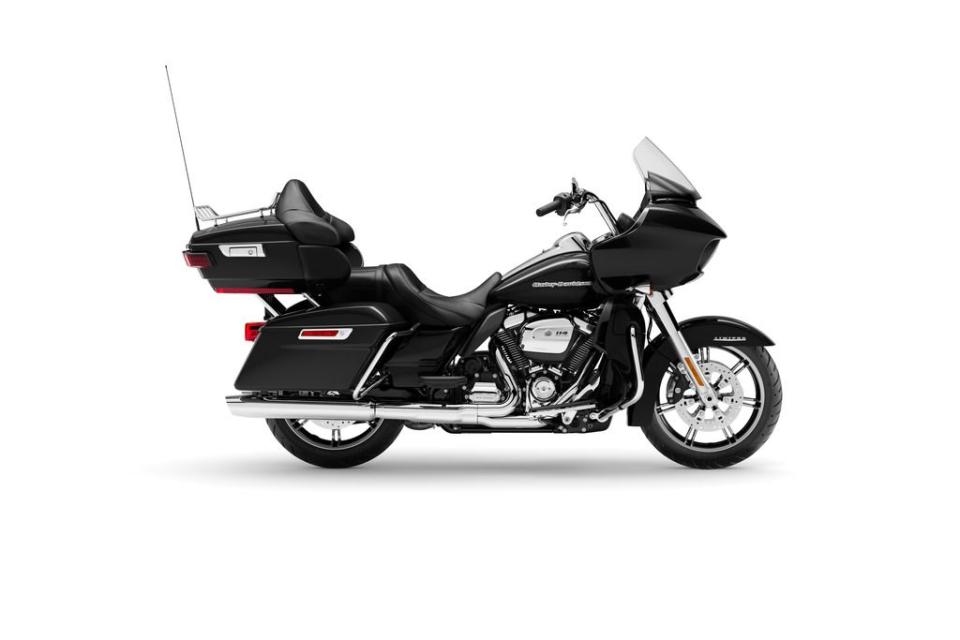
From Harley I chose the Road Glide Limited, the bike you’d want if you were planning a cross-country road stomp with your significant other riding on the back. The Road Glide Limited launched in 2019, replacing the Road Glide Ultra, which itself was new in 2011. The new bike’s mighty Milwaukee-Eight 114 air-cooled V-Twin makes a muscular 122 lb-ft of torque and 93 hp across a wide, very useable, very fun band. It has to, since the big brute weighs 932 pounds wet—about twice what your favorite sport bike weighs. If you want more power than that, there’s Harley’s Screaming Eagle catalog chock full of power upgrades for your engine. The Road Glide Limited starts at $28,729.
From Indian, I chose the Pursuit Dark Horse, a close competitor to the Harley Road Glide Limited. It starts at a whopping $30,999. The Indian’s PowerPlus Liquid-Cooled 108 cubic-inch V-Twin makes 122 hp and 128 lb-ft, which is 29 hp more than the Harley. But there are numerous configurations of both models that range from the mid-20s to the mid-30s, depending on how you load them up.
Both test bikes came with impressive audio systems, blasting tunes from speakers front and rear. Both have loads of lockable storage space, too. The Indian lists 5.6 cubic feet of remote locking storage while the Harley has 4.7 cubic feet. Both have top cases that will hold two full-face helmets. Both have six-gallon gas tanks. Harley lists 43 mpg for the Road Glide but Indian doesn’t show a mileage figure—published numbers range from 34 mpg to 37. So the Harley has a range of 258 miles and the Indian perhaps less, maybe 204 to 222 miles.
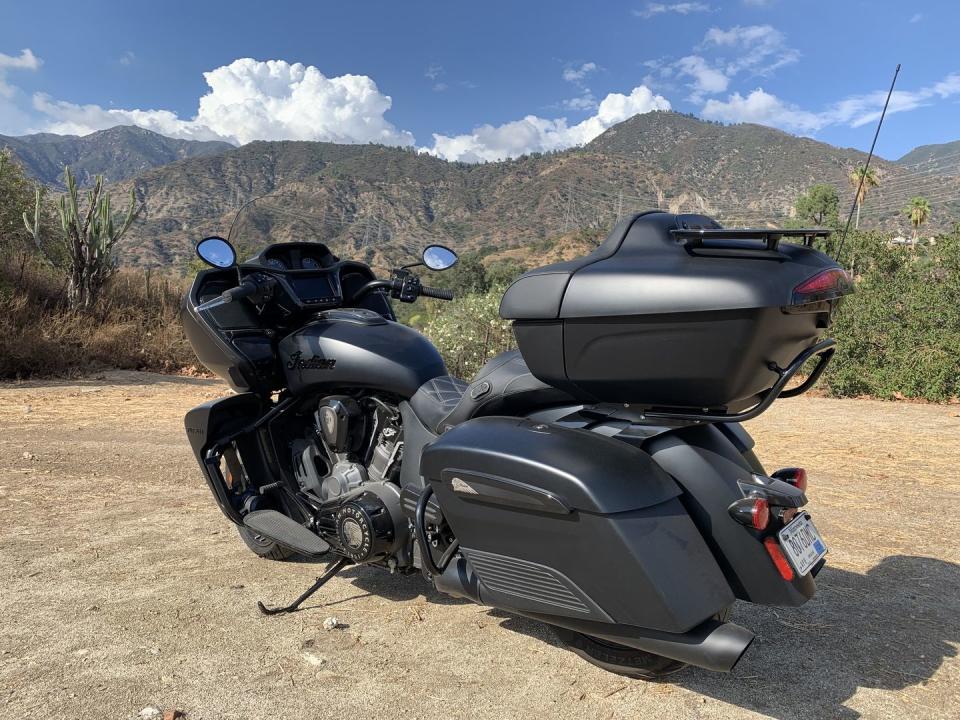
For a week I rode both of them back-to-back. Let me tell you how that went.
Both these bikes are big and, as I said, heavy. The Indian is 912 pounds full of fuel to the Harley’s 932. These are not good bikes for beginners. They are both solidly in the big American V-Twin cruiser category, where curb weight is more like kinetic energy waiting to be aimed somewhere. Aim them down the road and, like any objects in motion, they will tend to stay in motion until acted upon by a major force of nature. Or their brakes. Both bikes have good brakes, twin discs in front and a single disc rear—the Harley with 300 mm f/r and the Indian 320s front and 298 rear. Both have ABS standard. I took both up Angeles Crest Highway and went into the corners with verve and never wanted for more braking power, nor did I feel any fade on either bike. Granted, neither ever felt like a sport tourer on ACH (although the BMW K1600 GT did), but buyers aren’t expecting that from these two cross country cruisers.
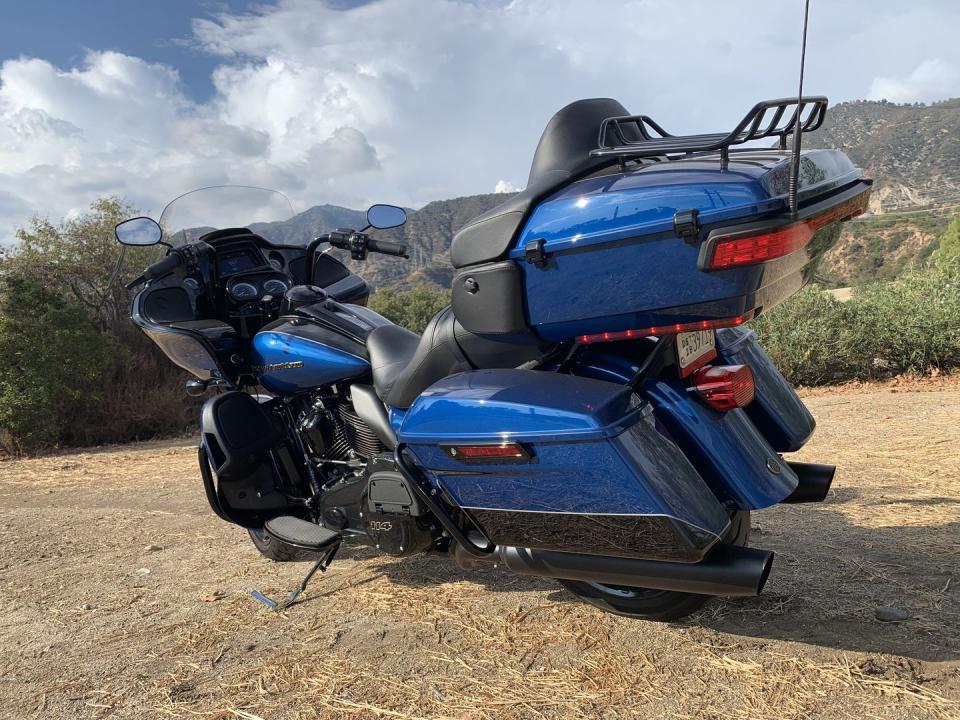
To remain upright in more normal riding, especially in slow-motion parking maneuvers where everyone is watching, these big, heavy bikes are most easily controlled by their torque. Twist the throttle and you get gobs of it instantly. You must trust in the torque, Luke. Master its subtle application and you will master these beasts, both of them. The same goes for twisty mountain roads. Easing out of corners is best done with just a minimal application of throttle from low engine speeds. The torque is there, waiting for you like a reliable friend, ready to lift you up from your lean and send you on your way.
Let’s look at the Harley. Right out of the parking space that mountain of torque announced itself, all 122 lb-ft. It made maneuvering easy, as long as you trust it. Stop trusting it, put a foot down, and then you might find yourself in trouble. The riding position is big-butt comfortable. Likewise, the handlebars are raised up a bit and pulled back to where you can easily reach them. You will be more comfortable in this riding position than maybe on just about any other bike.

Get on the freeway and the Road Glide feels remarkably happy cruising along at 90 mph. You might not even notice—you might just wonder why all the other cars around you are going so slow. Surprisingly, the vibration you may have feared from a whap-whap-whappping potato-potato-potato V-Twin is barely noticeable at speed. Power delivery is smooth across the tach. Mid-range torque is there in abundance, too. There’s almost never a need in plain-old regular riding for revs over 3000 rpm, though they are there, waiting to help, too. Cruising at 4000 rpm at 90 mph was about as smooth an experience as anything on two wheels.
Harley seems proud of its aerodynamic routing of air around the big fairing. The windscreen is supposed to reduce buffeting. And at first I was highly impressed with the lack thereof, especially compared to something like the BMW R18 Transcontinental, another competitor. But with my freakishly tall torso I’d like the windscreen just a little bit taller. It’s like Lamborghinis, made for shorter, more dashing pilotes.
I was very surprised, however, by the amount of heat pouring off the exhaust on the right side of the Harley. I actually checked several times to see if my pants were on fire (they weren’t). I checked the vent flap in the front fairing to make sure it was open. I checked to see that the EITMS was switched on—it was. (In 2007 Harley added a feature called Engine Idle Temperature Management System to address heat issues on its bikes. EITMS turns off the rear cylinder in certain conditions. The Indian has a similar setup.)
While the Indian is liquid cooled, the cylinders of the massive Harley V-Twin are still air-cooled, a heck of a throwback in this day and age but a feature beloved by Harley traditionalists. Its massive amounts of heat could be welcome on long winter rides but on the 100-degree days I had the bike it was almost unbearable (pre-written web comment: “Quit yer’ gullywumpin’ college boy! Suck it up an’ take the pain like a man!”).
To verify the heat, I went to the same place NASA gets all its scientific instruments (Harbor Freight Tools), bought a pyrometer, and did some measuring.
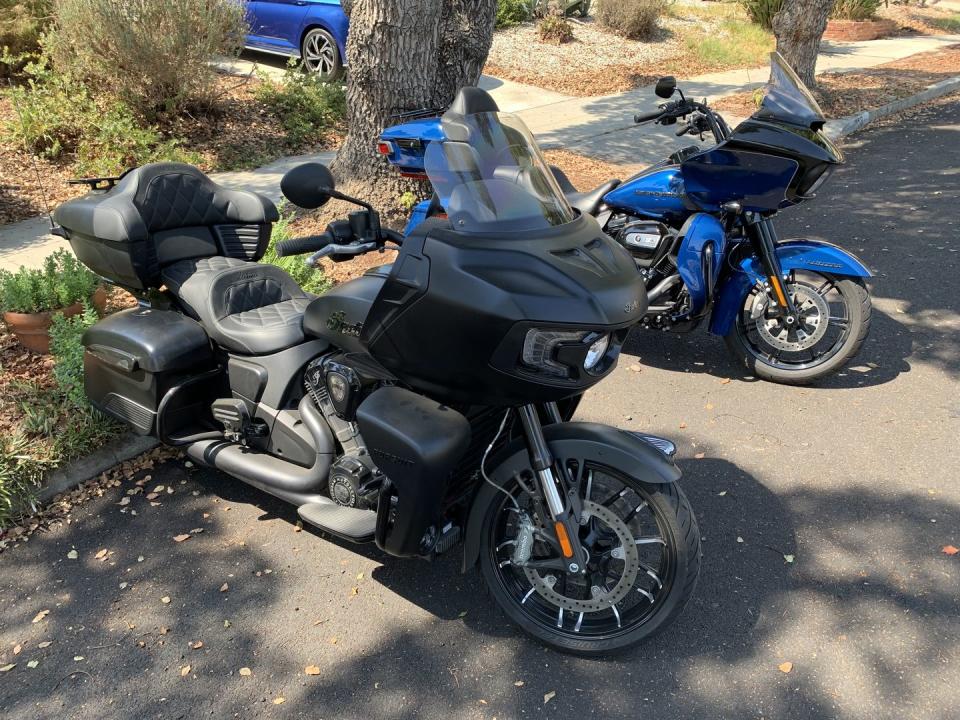
After riding both bikes on the same long uphill couple of miles in the same ambient temps, I aimed the pyrometer gun at various parts of the engine and exhaust. I found that the Indian is, indeed, cooler, almost 200 degrees cooler depending where you aim the gun. The middle of the exhaust pipe on the Harley was 380 degrees post-ride, for instance, while the same spot on the Indian was 188. The Harley was like a rolling Hibachi. At first I tried to block the heat with my gloved hand, then wound up riding with my right boot up on the fairing itself. This seemed workable and gave me a jaunty stance for anyone who happened to notice me ride by. Maybe this isn’t a problem for you tougher riders with skin of leather.
In addition to not roasting my own personal El Pollo Flaco leg meat, the Indian felt like it had more power and better handling. You notice the power right off the kickstand. The Indian felt tighter, like it had a higher torsional rigidity throughout. Neither manufacturer released torsional rigidity figures, so I was making this judgment by the seat of my (hot) pants.
Seating positions were likewise distinct: the Harley was a little more upright and felt just a bit more comfortable. The Indian felt more like a stylish seating position, as if an artist had drawn an eager rider on a motorcycle, then the designers had matched that. You lean just a little farther forward on the Indian. Both are entirely comfortable seating positions, just a bit more so on the Harley.
If I had to boil down the differences, both bikes would be comfortable enough in ride and seating position to cruise across the country in fine style, but the heat from the Harley was a deal breaker for me. Plus, the sportier feel and response from the Indian Pursuit Limited compared to the slightly softer overall feel of the Road Glide made the choice easier. Winner: Indian, in my opinion.
This is a big, big class, with entries from manufacturers across the board and around the world. While Harley and Indian are the bikes of choice for riders driven by their pride in American products and in the long heritage of both those makes, the choices run the gamut. Or ride the gamut.
If you’re planning to chuck it all and cross the country, you should also consider the following:
Honda Goldwing, a massive flat-six-powered ultra-cruiser juggernaut that even comes with an automatic transmission, the latter which I really liked. Those start at $25,300 and go up to $32,800 with airbag and DCT.
BMW K1600 GT has a transverse-mounted straight-six and feels almost like a sport tourer. It makes 160 hp and 133 lb-ft of torque and is as at home leaning into a curve on a mountain road as riding from LA to Miami. Prices range from $24,690 to $28,540.
The Yamaha FJR1300 was redesigned in 2016 and does a fine job of keeping the sport in sport touring. At 635 pounds, its 300 pounds lighter than the Harley/Indian competitors, and with 142 hp and 99 lb-ft of torque it still has a better weight-to-power ratio. Pricing starts at $18,199.
Among adventure bikes, consider the BMW R1250 GS Adventure, Ducati Multistrada, and Suzuki V-Strom 1050, all of which I’ve ridden and all of which I wouldn’t hesitate to take from California to New York.
These are great times to be a motorcycle enthusiast, so pick the bike that’s right for you and go ride!
What's your favorite motorcycle for long-haul cruising? Please comment below.

 Yahoo Autos
Yahoo Autos 